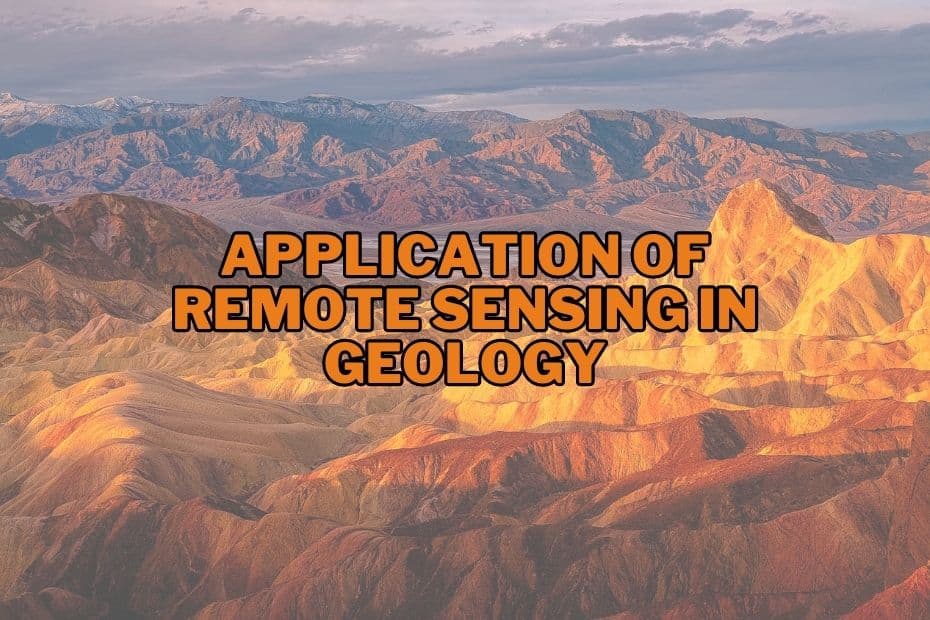In the era of space-age technology, remote sensing has become a powerful tool for geological studies. It employs satellites and airborne devices to observe and record data about the Earth’s surface and its features. Let’s delve into the numerous application of remote sensing in geology.
Remote Sensing enables geologists to gather vital data about the Earth’s surface and subsurface without physical contact. This technology aids in mapping geological features, identifying mineral deposits, monitoring land use changes, and assessing natural hazards.
Application of Remote Sensing In Geology
Remote sensing offers geologists a high-tech eye in the sky. This bird’s eye view provides detailed insight into our planet’s geological processes and features, from landforms and structures to mineral composition and the effects of natural disasters. But how exactly is this technology employed in the field of geology? Let’s explore.
1. Mineral Exploration
One of the most important application of remote sensing in geology is mineral exploration. With technologies like hyperspectral imaging and radar, geologists can detect the spectral signatures of various minerals. This allows them to identify, map, and quantify mineral deposits remotely, leading to discoveries that would have been impossible with conventional ground surveys alone.
2. Landform Analysis
Landform analysis is another key area where remote sensing technology plays a crucial role. By capturing large-scale images of the Earth’s surface, geologists can analyse terrain morphology, land use, and slope stability. This can help in understanding the geological history of an area, predicting future geological events, and making informed decisions on land use planning.
3. Geological Hazard Assessment
Remote sensing is invaluable in monitoring and predicting geological hazards such as earthquakes, landslides, and volcanic eruptions. Through various sensors and imagery, geologists can assess risk levels, identify vulnerable areas, plan evacuation routes, and even initiate early warning systems. The use of remote sensing in this context helps to save lives and reduce damage to infrastructure.
4. Sedimentation Studies
Through remote sensing, geologists can monitor and understand sediment transport and deposition patterns as well as erosion rates over large areas. This information is critical for managing natural resources, environmental conservation efforts, and understanding how the landscape is changing over time.
5. Structural Geology
Technologies like satellite imagery and radar interferometry are indispensable for studying structural geology. They allow geologists to detect and analyse the Earth’s structural features such as faults, folds, and joints. This helps in understanding the forces and processes involved in the Earth’s crustal deformation and mountain-building processes.
6. Paleogeographic Reconstructions
Remote sensing also aids in the identification and reconstruction of ancient geographical features. By studying changes in the landscape over time, geologists can reconstruct the Earth’s past environments, which helps to understand its geological history and the evolutionary processes that have shaped it.
7. Glaciology Studies
In the field of glaciology, remote sensing plays a pivotal role. By tracking changes in polar ice caps, glaciers, and sea ice, scientists can gain insights into climate change and its potential impact. It’s also useful in studying glacial dynamics and processes, contributing to our understanding of the Earth’s water cycle.
8. Hydrogeological Applications
Remote sensing is invaluable in identifying and mapping groundwater resources, assessing aquifer characteristics, and monitoring water pollution. This information aids in water resource management, helping to ensure sustainable water supply and protect water quality.
9. Seabed Mapping
Underwater remote sensing technologies such as sonar allow for detailed mapping of the seabed. This provides essential information for understanding marine geology, exploring resources beneath the ocean floor, and studying marine life habitats.
10. Soil Study
Soil characteristics, including moisture content, organic matter, and mineral composition, can be assessed remotely. This provides critical data for agricultural practices, land use planning, and environmental conservation.
11. Atmospheric Studies
Remote sensing technologies help in studying the Earth’s atmosphere, tracking changes in weather patterns, climate change, and pollution levels. This information is crucial for environmental monitoring, weather forecasting, and climate research.
12. Extraterrestrial Geology
Remote sensing has expanded the field of geology beyond the confines of our planet. It allows scientists to study the geology of other planets, moons, and asteroids, helping us understand the universe and our place within it.
Conclusion
The application of remote sensing in geology are broad and transformative. By providing unparalleled insights into the Earth’s surface and subsurface, this technology continues to revolutionize the field of geology. With ongoing advancements, we can anticipate an even deeper understanding of our world and the universe beyond.
FAQs: Application of Remote Sensing In Geology
What is remote sensing in geology?
Remote sensing in geology refers to the use of technologies to study geological phenomena without physical contact.
Can remote sensing be used beyond Earth?
Yes, remote sensing is also used in studying the geology of other planets, moons, and asteroids.
How is remote sensing applied in geology?
Remote sensing aids geology by providing data about the Earth’s surface for identifying natural hazards, locating mineral resources, and studying landforms, among other things.
What are some challenges of using remote sensing in geology?
Challenges include issues with image resolution, interference from cloud cover, and the high cost of satellite data.
